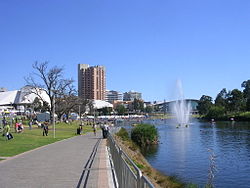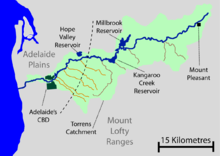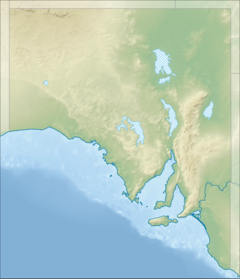
Back نهر تورنز Arabic نهر تورنز ARZ Торэнс (рака) Byelorussian Torrens River (suba sa Ostralya, State of South Australia) CEB Торренс (юханшыв) CV River Torrens German Río Torrens Spanish Torrensi jõgi Estonian Torrens (fleuve) French Torrens (rijeka) Croatian
| Torrens Karrawirra Parri[1] | |
|---|---|
 View of Elder Park, the Riverside Precinct and the Torrens Lake, before construction of the pedestrian bridge in 2014. | |
 Torrens catchment, creeks and reservoirs | |
Location of the river mouth in South Australia | |
| Etymology | Robert Torrens[2] |
| Native name | |
| Location | |
| Country | Australia |
| State | South Australia |
| Region | Adelaide Plains |
| Physical characteristics | |
| Source | Mount Lofty Ranges |
| • location | Mount Pleasant |
| • elevation | 480 m (1,570 ft) |
| Mouth | Gulf St Vincent |
• location | Henley Beach South |
• coordinates | 34°55′S 138°36′E / 34.917°S 138.600°E |
• elevation | 0 m (0 ft) |
| Length | 85 km (53 mi) |
| Basin size | 508 km2 (196 sq mi) |
| Discharge | |
| • location | mouth[3] |
| • average | 0.71 m3/s (25 cu ft/s) |
| Basin features | |
| Reservoir | Kangaroo Creek Reservoir |
| [4] | |

Tapleys Hill Road
The River Torrens /ˈtɒrənz/ (Karrawirra Parri / Karrawirraparri) is the most significant river of the Adelaide Plains. It was one of the main reasons for the siting of the city of Adelaide, capital of South Australia. It flows 85 kilometres (53 mi) from its source in the Adelaide Hills near Mount Pleasant, across the Adelaide Plains, past the city centre and empties into Gulf St Vincent between Henley Beach South and West Beach. The upper stretches of the river and the reservoirs in its watershed supply a significant part of the city's water supply.
The river is also known by the native Kaurna name for the river—Karrawirra Parri or Karrawirraparri (karra meaning redgum, wirra meaning forest and parri meaning river), having been officially dual-named in 2001.[1][5] Another Kaurna name for the river was Tarndaparri (Kangaroo river).[6] The river was thought to be a reflection of the Milky Way ("wodliparri"), and was the heartland of the Kaurna people, who lived along its length and around the tributary creeks.[7]
At its 1836 exploration by William Light, an inland bend was chosen as the site of the Adelaide city centre and North Adelaide. The river was first named the Yatala by the initial exploration party, but later renamed to honour Robert Torrens senior, chairman of the board of Colonisation Commissioners for South Australia from 1834 to 1841 (when he was sacked). From March 1837 settlers camped in tents and makeshift huts along the west end of the River Torrens and freely used the river's resources. A Native Location was created on the north banks of the Torrens and indigenous labour was often used by the settlers for tasks such as hewing wood or delivering water.[8] During the early years of settlement, the river acted as both the city's primary water source and main sewer, leading to outbreaks of typhoid.[9]
Since European settlement the river has been a frequently touted tourist attraction. The river's long linear parks and a constructed lake in the lower stretch are iconic of the city. The river's flora and fauna have been both deliberately and accidentally impacted since settlement. In the 19th century, native forests were cleared, gravel removed for construction and many foreign species introduced. With construction of the linear parks, many species native to the river have been replanted, and introduced species have been controlled as weeds.
The river and its tributaries are highly variable in flow, and together drain an area of 508 square kilometres (196 sq mi). They range from sometimes raging torrents, damaging bridges and flooding city areas, to trickles and completely dry in summer. Winter and spring flooding has prompted the construction of flood reduction works. A constructed sea outlet, landscaped linear parks and three holding reservoirs contain peak flow.
- ^ a b "Notice to Assign Dual Names to Places" (PDF). South Australian Government Gazette. Government of South Australia. 15 November 2001. Archived (PDF) from the original on 29 March 2019. Retrieved 23 July 2019.
NOTICE is hereby given [that the] Minister of the Crown to whom the administration of the Geographical Names Act 1991, is committed do hereby 1. Assign the name Karrawirra Parri as an alternative name to that feature also known as River Torrens. Both names, separately or together, would have equal validity as the name of the subject feature [...]
- ^ Cite error: The named reference
Vol1,vwas invoked but never defined (see the help page). - ^ Noted as 22.4 GL (790 million cu ft) per year in Adelaide coastal waters study (Spring 2004). "Summary of the literature review and stormwater audit (pdf)" (PDF). City to Sea. 1 (4): 2. Archived from the original (PDF) on 30 September 2009. Retrieved 9 September 2009.
- ^ "Map of River Torrens, SA". Bonzle Digital Atlas of Australia. Archived from the original on 30 October 2021. Retrieved 25 March 2017.
- ^ "River Torrens". SA Location Viewer. Government of South Australia. 7 March 2013. SA0033903. Archived from the original on 19 July 2019. Retrieved 23 July 2019.
Portions of the river also known by the Aboriginal people as Karra Wirra Parri (that portion in the City of Adelaide), Korraweera (at Hindmarsh), Karraundo Ingga (reedbeds), Witoingga (whole river), Perre, Peere or Parri (in flood) and Yertala
- ^ "Karrawirraparri 'Red gum forest river' (River Torrens)". City of Charles Sturt. 12 August 2013. Archived from the original on 17 March 2020. Retrieved 26 February 2020.
- ^ "Reconciliation". Adelaide City Council. Archived from the original on 12 July 2019. Retrieved 26 February 2020.
- ^ Sharyn Clarke, "The Creation of the Torrens: A History of Adelaide's River to 1881", University of Adelaide MA Thesis, 2005
- ^ KESAB. "A LITTLE CATCHMENT HISTORY". Catchment Boards of South Australia. Archived from the original on 3 October 2006. Retrieved 21 November 2006.
New site: http://www.amlrnrm.sa.gov.au Archived 24 October 2007 at the Wayback Machine Active on 9 September 2009.
© MMXXIII Rich X Search. We shall prevail. All rights reserved. Rich X Search
